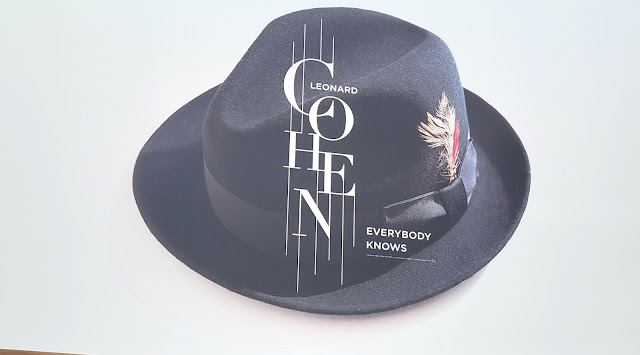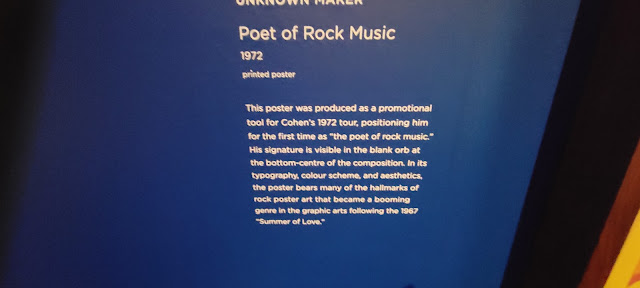March 2023 - Toronto ON
We saw the Leonard Cohen: Everybody Knows exhibit at the AGO (Art Gallery of Ontario) this week.
We are huge Cohen fans!
RIP
An enduring artistic force, Canadian novelist, poet and singer-songwriter Leonard Cohen (1934-2016) is renowned the world over for his meditations on beauty, death, loss and the human heart.
Thanks to Leonard Cohen Family Trust the exhibition boasts an incredible number of personal items from the late artist — from diaries, letters and ephemera to hundreds of private photographs and even his Grammy award!An enduring artistic force, Canadian novelist, poet and singer-songwriter Leonard Cohen (1934-2016) is renowned the world over for his meditations on beauty, death, loss and the human heart.
Cohen understood the importance of preserving his work, so he has been saving everything from the early stages of his career, and now hundreds of his personal items are part of the University of Toronto archives.
Click here for the AGO audio tour and soundtrack, it will describe in detail many of the photos below.
I didn't know that he was quite an artist.
Cohen is mostly known as a poet and singer-songwriter, famously for his songs “Hallelujah”, “I am Your Man” and “Everybody Knows”, after which the exhibition is titled. Yet, this exhibition showcases that Cohen also had talents in visual mediums, in photography and drawing. His lifelong interest in graphic arts was kept relatively private until several exhibitions were staged in 2007. He did not want to be remembered as a visual artist, yet his albums and touring merchandise’s imagery had been influenced directly by his artworks.The AGO always use the stairs to promote an exhibit.
Leonard Cohen (1934-2016) was a Canadian poet, singer-songwriter and novelist. His music, lyrics and books, which have been read by generations of readers, are admired globally. Born and educated in Montreal, Cohen’s artistic career began in 1956 with the publication of his first book of poetry, Let Us Compare Mythologies. Over his long and productive career, he published numerous books of poetry and two novels, The Favourite Game and Beautiful Losers, and in 1993, Stranger Music: Selected Poems and Songs. He has recorded more than a dozen music albums, and numerous tribute albums, in many languages, have celebrated his songs. He died in Los Angeles in 2016 (the day before the US election) and was secretly buried in Montreal a few days later.
It establishes the origins of Cohen’s deep Judaic faith, which informed his world view even as he voraciously studied other religions and spent six years during the 1990s sequestered at a Zen Buddhist monastery.
The show offers a peek into the hundreds of pocket-sized notebooks that, over the years, Cohen would always carry with him, writing down ideas for couplets or for songs. Sometimes he would sketch or doodle on a napkin or a piece of cardboard.
The Spice-Box of Earth is Canadian poet and songwriter Leonard Cohen's second collection of poetry. It was first published in 1961 by McClelland and Stewart, when Cohen was 27 years old. The book brought the poet a measure of early literary acclaim.
Handwritten Everybody Knows.
John, it is quiet as 10:30 to 11:30 is for members only. It got very busy after that.
Photography was a critical medium for Cohen, who enjoyed documenting himself, being both in front and behind the camera. He carefully controlled his image. Also, his fascinations with everyday objects — from Shabbat candles to his son’s cup — is presented through polaroids, sketches and watercolours. His handwritten postcards and notebooks with well-known lyrics are on display for visitors to see.
Did you know? Cohen's classic song "Hallelujah," which has been covered by hundreds of artists, originally appeared on his 1984 album, Various Positions. The song entered the Billboard Hot 100 for the first time in December 2016 following his passing.
I found this image of the original book cover online.
2008 Induction into the Rock and Roll Hall of Fame.
He was honored with a Recording Academy Lifetime Achievement Award in 2010. Songs Of Leonard Cohen was inducted into the GRAMMY Hall Of Fame in 2015.
2017 Grammy Award, Best Rock Performance for "You Want it Darker."





































.JPG)




.jpg)
.jpg)
.jpg)







